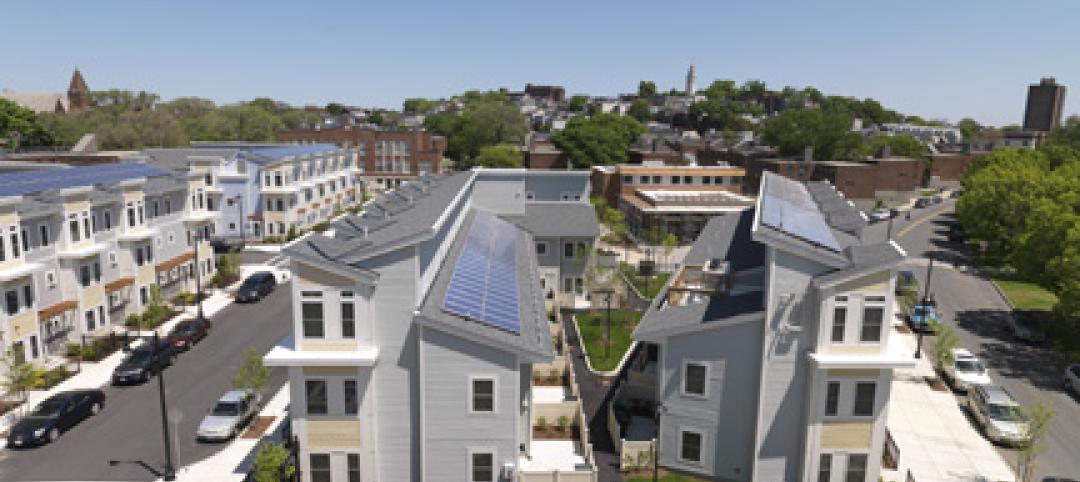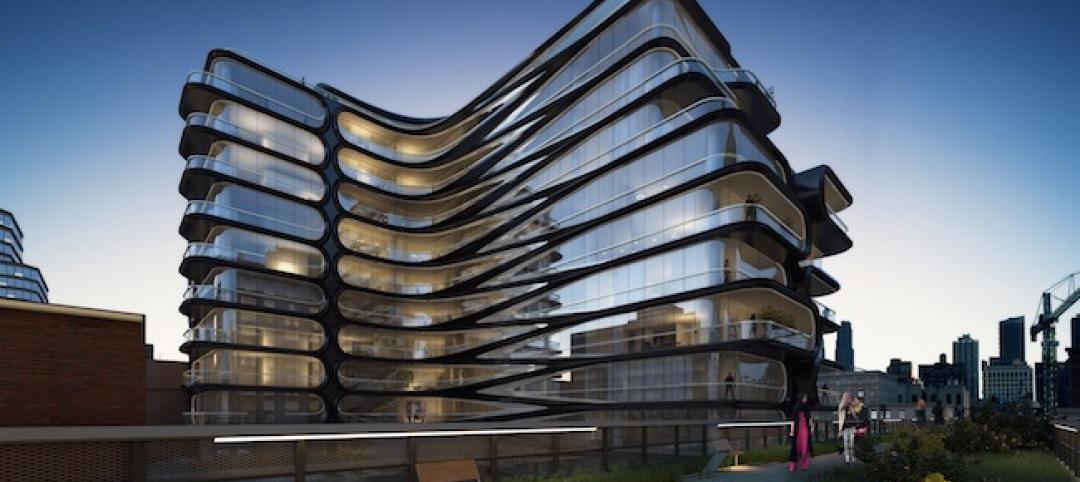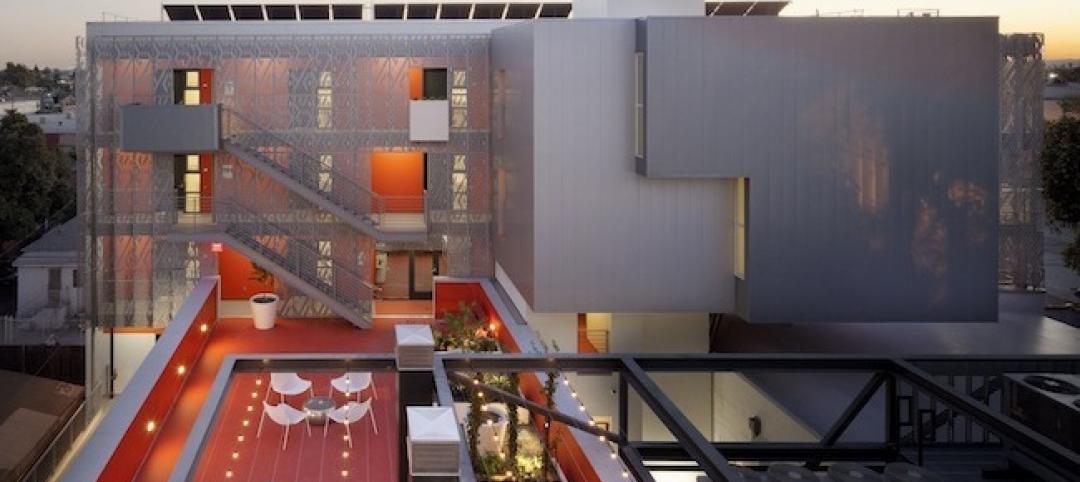HUB 32, a 65-unit multifamily housing development, will provide affordable housing and community amenities in Chicago’s Garfield Park neighborhood.
Brooks + Scarpa’s recently unveiled design takes inspiration from the American tradition of patchwork and quilting. The panels on the building’s exterior create a sense of depth and texture that’s meant to evoke the feeling of a handmade quilt. In addition to providing warmth and comfort, the use of quilting and stitching to inform the design draws on Chicago’s rich textile tradition.
“By incorporating elements of the city’s textile tradition into the design of our building, we hope to create a sense of connection and belonging for our residents,” Brooks + Scarpa says in a statement.
The design of the multifamily housing project also takes cues from the city’s centuries-old history of courtyard buildings. HUB 32 has an elevated courtyard that sits above ground-level commercial space. The courtyard creates usable space at the center of the project, and for the people living around it, the courtyard will provide privacy and safety.
The courtyard also will help the structure fit with its surrounding neighborhood. In addition, the strategic placement of the units and windows will orient the apartments to social spaces that sit apart from each other yet are visually connected to each other and to the street.
Brooks + Scarpa says the building’s design follows its five guiding principles of equity, innovation, a sense of place, environmental stewardship, and community engagement. The design firm says it will partner with local organizations to promote sustainability and support community events and initiatives. “Design excellence … can and should be for everyone,” the firm says in its statement.
On the Building Team:
Owner/developer: KMW Communities and Michaels
Design architect: Brooks + Scarpa
Architect of record: Studio Dwell
MEP engineer: Quest Design Group
Structural engineer: Rockey Structures

Here is the full design statement from Brooks + Scarpa:
The design of HUB 32, a 65-unit mid-rise residential building in Chicago is inspired by the concept of quilting and stitching. The inspiration came from American patchwork quilting traditions, exemplified by the Gee's Bend abstract geometric style-which is itself influenced by newspaper- and magazine-collages used for insulation on the inside walls of homes in the early rural American.
The exterior of the building is adorned with a series of materials and forms that mimic the appearance of a quilt, with each part representing a different pattern or color. These panels are arranged in a way that creates a sense of depth and texture, evoking the feeling of a cozy, handmade quilt.
The idea behind using quilting and stitching as the basis for the design was to create a sense of warmth and comfort, as well as a connection to the rich textile tradition of Chicago. The city has a long history of textile production, and we wanted to pay tribute to that history by incorporating these elements into the design of our building.
Overall, the building is designed to be a welcoming and comfortable place for its residents. Taking cues from the rich history of courtyard buildings in Chicago such as Pattington Apartments, the building is designed around an elevated courtyard above ground level commercial space. The courtyard typology has existed in Chicago for more than two hundred years. It promotes pedestrian-oriented neighborhoods as an alternative to sprawl, creating usable space in the center of the project, instead of unused, leftover space outside of the building volume.

More than any other multi-dwelling housing, courtyard apartments, “make you feel like you belong to a place.” For people living around the courtyard, the space provides a sense of safety and privacy; the courtyard is a quasi-public space that mediates between the home and the street. For the city at large, the courtyard is an urbane housing type that fits well into neighborhoods. Strategically placed windows, purposeful exterior elements and units that wrap the outer-most edges, orient the apartments to social spaces that are spatially apart, yet visually connected to each other and the street below.
In addition, the design of the building follows our five guiding principals: equity, innovation, a sense of place, environmental stewardship, and community engagement.
Design excellence is not mutually exclusive. It can, and should be for everyone. In terms of equity, we are committed to creating a building that is accessible and welcoming to all members of the community, regardless of their background or circumstances.


We are also committed to innovation, and are constantly seeking out new ways to improve the design and functionality of our building. This includes incorporating sustainable technologies and materials wherever possible, in order to reduce our environmental impact and provide our residents with a high-quality living experience. We embrace a creative approach to design and problem solving.
A sense of place is important to us, and we want our building to be a reflection of the unique character and history of Garfield Park and the City of Chicago. By incorporating elements of the city's textile tradition into the design of our building, we hope to create a sense of connection and belonging for our residents.
Finally, we are committed to environmental stewardship and community engagement. We believe that it is our responsibility to be good stewards of the environment and to work together with the community to create a better future for everyone. This includes initiatives such as partnering with local organizations to promote sustainability and supporting community events and initiatives.












Related Stories
| May 27, 2014
America's oldest federal public housing development gets a facelift
First opened in 1940, South Boston's Old Colony housing project had become a symbol of poor housing conditions. Now the revamped neighborhood serves as a national model for sustainable, affordable multifamily design.
| May 23, 2014
Big design, small package: AIA Chicago names 2014 Small Project Awards winners
Winning projects include an events center for Mies van der Rohe's landmark Farnsworth House and a new boathouse along the Chicago river.
| May 22, 2014
No time for a trip to Dubai? Team BlackSheep's drone flyover gives a bird's eye view [video]
Team BlackSheep—devotees of filmmaking with drones—has posted a fun video that takes viewers high over the city for spectacular vistas of a modern architectural showcase.
| May 22, 2014
NYC's High Line connects string of high-profile condo projects
The High Line, New York City's elevated park created from a conversion of rail lines, is the organizing principle for a series of luxury condo buildings designed by big names in architecture.
| May 20, 2014
Kinetic Architecture: New book explores innovations in active façades
The book, co-authored by Arup's Russell Fortmeyer, illustrates the various ways architects, consultants, and engineers approach energy and comfort by manipulating air, water, and light through the layers of passive and active building envelope systems.
| May 20, 2014
World's best new skyscrapers: Renzo Piano's The Shard, China's 'doughnut hotel' voted to Emporis list
Eight other high-rise projects were named Emporis Skyscraper Award winners, including DC Tower 1 by Dominique Perrault Architecture and Tour Carpe Diem by Robert A.M. Stern.
| May 16, 2014
BoA, USGBC to offer $25,000 grants for green affordable housing projects
The Affordable Green Neighborhoods Grant Program will offer 14 grants to developers of affordable housing in North America who are committed to building sustainable communities through the LEED for Neighborhood Development program.
| May 13, 2014
19 industry groups team to promote resilient planning and building materials
The industry associations, with more than 700,000 members generating almost $1 trillion in GDP, have issued a joint statement on resilience, pushing design and building solutions for disaster mitigation.
| May 12, 2014
The best of affordable housing: 4 projects honored with 2014 AIA/HUD Secretary Awards [slideshow]
The winners include two dramatic conversions of historic YMCA buildings into modern, affordable multifamily complexes.
| May 11, 2014
Final call for entries: 2014 Giants 300 survey
BD+C's 2014 Giants 300 survey forms are due Wednesday, May 21. Survey results will be published in our July 2014 issue. The annual Giants 300 Report ranks the top AEC firms in commercial construction, by revenue.
















